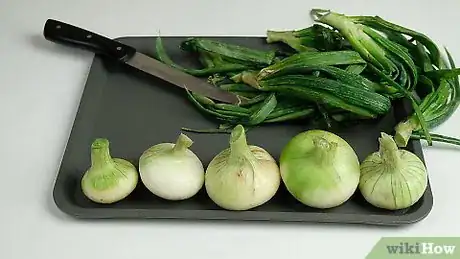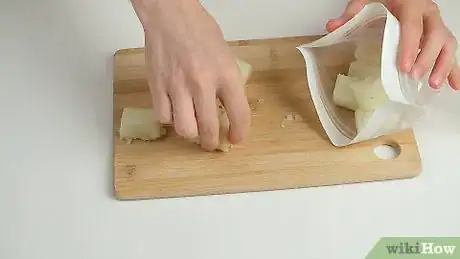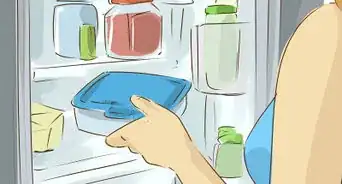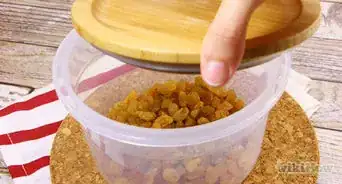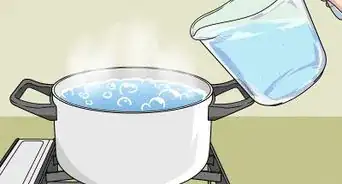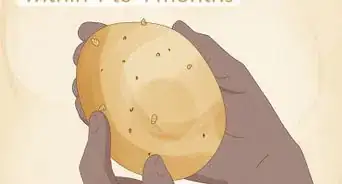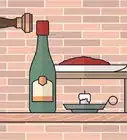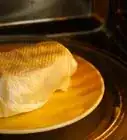This article was co-authored by wikiHow Staff. Our trained team of editors and researchers validate articles for accuracy and comprehensiveness. wikiHow's Content Management Team carefully monitors the work from our editorial staff to ensure that each article is backed by trusted research and meets our high quality standards.
The wikiHow Video Team also followed the article's instructions and verified that they work.
This article has been viewed 8,669 times.
Learn more...
Onions are an indispensable feature of any kitchen. They’re used in so many recipes that you probably always want to have some on hand. But if you have more onions than you can use at once, don’t fear. There are three simple ways to preserve onions. You can cure and store them whole; dehydrate them; or freeze them.
Steps
Curing and Storing Whole Onions
-
1Cure freshly-harvested onions by laying them in a dry place. Spread your onions in a single layer in a warm, dry place, like the floor of a garage. Wait until the necks of the onions are no longer green and the stems are dry. This may take more than a week!
- Once your onions are cured, trim their roots off with scissors. The onions are ready to store.[1]
- If you’ve bought your onions at the supermarket, they’re already cured.
-
2Place the onions in mesh bags. The mesh will make sure they stay dry. If you have lots of onions that you want to keep organized after a harvest, sort the onions by size and place them in separate mesh bags.[2]
- Do not wash your onions before storing them. The dampness from washing the onions would be the perfect habitat for mold.[3]
Advertisement -
3Store the onions in a cool, dark, dry spot. The ideal temperature is between 32° F (0°C) and 40° F (4.4°C). A garage, shed, cellar, or dark closet will do. If you have a root cellar, it may be slightly warmer, but that’s all right.[4]
- Mild onions should be used within a few weeks. Pungent onions can last months in storage.[5]
-
4Use a dehumidifier if you live in a humid climate. High humidity causes onions to sprout, rot, and grow mold. A dehumidifier will keep the humidity down and make sure your onions stay good. Check your onions regularly for soft spots and sprouting.
- Even if you don’t live in a particularly humid climate, make sure that you’re storing your onions in a well-ventilated place, to prevent rot.
Dehydrating Onions
-
1Peel the onions and slice them into 1⁄8 in (0.32 cm) rings thick. Peel off the outer paper shells of the onions, then cut off the tops and root ends of each one. Place an onion on a cutting board, then slice it into 1⁄8 in (0.32 cm) using a large, non-serrated knife.[6]
- Remember to always use caution when you're using a knife. Hold the onion securely with your free hand so it doesn't slip when you're cutting it. As you do that, be sure to keep your fingers curled in toward the palm of your hand so you don't cut yourself.
-
2Place the onion slices in a dehydrator at 140°F (60°C) until they’re nearly dry. Check their drying progress every hour. Depending on the onions and humidity, it may take 3 to 9 hours to get the onion rings almost all the way dry.[7]
- Stop before they are entirely dry to prevent browning them.
-
3Turn the temperature down to 130°F (54°C) and dry the onions another hour. Turning the temperature down will keep the onions from browning. Keep testing for dryness every ten minutes, and take the onions out when they are all the way dry.[8]
- If you don’t own a dehydrator, try drying your onions in the oven. Spread the rings on a cookie sheet and leave them in a slightly warm oven for many hours, checking dryness regularly.[9]
-
4Remove the onions from the dehydrator, cool, and store them. Make sure the onions are completely cool before you place them into a sealed container. Store your dehydrated onions in a cool, dry place. Properly stored, dehydrated onions can last up to 2 years![10]
Freezing Onions
-
1Chop of the root ends and the onion tops. Place the onions on a cutting board, and cut off the tops and roots with a large, unserrated knife. Make sure keep your fingers away from the knife blade.[11]
-
2Slice the onion in half and peel. Place the onion upright on the flat surface that you’ve made by cutting off the onion top. Slice the onion vertically down the middle. This will make it easier to peel. Then peel off the papery outer layers of the onion. Stop peeling when the layers are fleshy, but don't worry if you've peeled a few extra layers by accident.[12]
-
3Puree the onions in a blender or food processor. Depending on the strength of your blender, you may need to chop your onions into smaller pieces before putting them into the blender. Blend until there are no chunks and it's a nice, smooth consistency.
-
4Pour the puree into ice cube trays and freeze. Let the cubes freeze overnight. Once they are all frozen, take them out of the ice cube tray. They should be totally solid, so if they still seem mushy, freeze them for longer.[13]
-
5Transfer the cubes of onion puree into a plastic bag in your freezer. This will free up your ice cube trays for making ice. Your frozen onion cubes will be great for soups and gravies.[14]
- Make sure you wash your trays thoroughly before using again. They are going to have quite the scent!
- Use frozen onions within a month or two for best flavor.[15]
References
- ↑ https://www.gardeners.com/how-to/harvest-cure-store-onions/7366.html
- ↑ https://www.gardeners.com/how-to/harvest-cure-store-onions/7366.html
- ↑ https://garden.org/learn/articles/view/502/
- ↑ https://garden.org/learn/articles/view/502/
- ↑ https://www.gardeners.com/how-to/harvest-cure-store-onions/7366.html
- ↑ https://www.realsimple.com/food-recipes/cooking-tips-techniques/preparation/chop-peel-onion
- ↑ https://www.canr.msu.edu/news/simple_steps_to_harvesting_and_preserving_onions
- ↑ https://www.canr.msu.edu/news/simple_steps_to_harvesting_and_preserving_onions
- ↑ https://garden.org/learn/articles/view/502/
- ↑ https://garden.org/learn/articles/view/502/
- ↑ https://www.realsimple.com/food-recipes/cooking-tips-techniques/preparation/chop-peel-onion
- ↑ https://garden.org/learn/articles/view/502/
- ↑ https://garden.org/learn/articles/view/502/
- ↑ https://garden.org/learn/articles/view/502/
- ↑ https://garden.org/learn/articles/view/502/
- ↑ https://food.unl.edu/freezing-onions
- ↑ https://garden.org/learn/articles/view/502/
